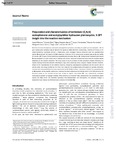Preparation and Characterization of Terdentate [C,N,N] Acetophenone and Acetylpyridine Hydrazone Platinacycles: A DFT Insight Into the Reaction Mechanism

Use this link to cite
http://hdl.handle.net/2183/38391Collections
- Investigación (FCIE) [1227]
Metadata
Show full item recordTitle
Preparation and Characterization of Terdentate [C,N,N] Acetophenone and Acetylpyridine Hydrazone Platinacycles: A DFT Insight Into the Reaction MechanismAuthor(s)
Date
2017-11-13Citation
I. Marcos, V. Ojea, D. Vázquez-García, J. J. Fernández, A. Fernández, M. López-Torres, J. Lado and J. M. Vila, Preparation and characterization of terdentate [C,N,N] acetophenone and acetylpyridine hydrazone platinacycles: a DFT insight into the reaction mechanism, Dalton Trans., 2017, 46, 16845–16860.
Abstract
[Abstract] The reaction of N-ortho-chlorophenyl-substituted acetylpyridine hydrazones (a and d) with K2[PtCl4] (n-butanol/water, 100 °C) gave mononuclear complexes 1a and 1d with the ligands as [N,N] bidentate. In contrast, the reaction of N-phenyl or N-meta-chlorophenyl hydrazones (b and c, respectively) under analogous reaction conditions gave the cycloplatinated species 2b and 2c with the ligand as [C,N,N] terdentate. The treatment of the mononuclear complexes 1a and 1d with NaOAc (n-butanol, 100 °C) gave the corresponding cycloplatinated complexes 2a and 2d. Acetophenone hydrazone platinacycle 2e was prepared in a similar fashion and its reaction with tertiary mono- and triphosphines gave mono- or trinuclear species depending on the reaction conditions. The X-ray crystal structures of some of these complexes showed interesting π–π slipped stacking interactions between metallacyclic rings which, according to NCI analyses, showed an aromatic character. With an aim to rationalize the different reactivities shown by acetylpyridine hydrazones and the precise role of the acetate anion, the energy profiles for the three main steps of cycloplatination (iminoplatinum complex formation, chelation and cyclometallation) have been determined by using the DFT (M06) methods. Calculations indicate that the cycloplatination of 1b proceeds via electrophilic substitution, involving the direct replacement of the chloride anion at the Pt(II) centre with the N-phenyl moiety as the rate-determining step, to give an agostic intermediate 5b+ that, subsequently, leads to the elimination of a proton as hydrogen chloride. When present as an “external” base, acetate enters the coordination sphere around the Pt(II) centre and facilitates hydrazone N–H deprotonation and electrophilic C–H activation through a dissociative route, leading to a Wheland-type σ-complex intermediate 9ac.
Description
Author accepted manuscript
Editor version
ISSN
1477-9234





